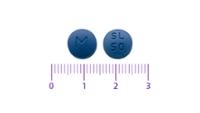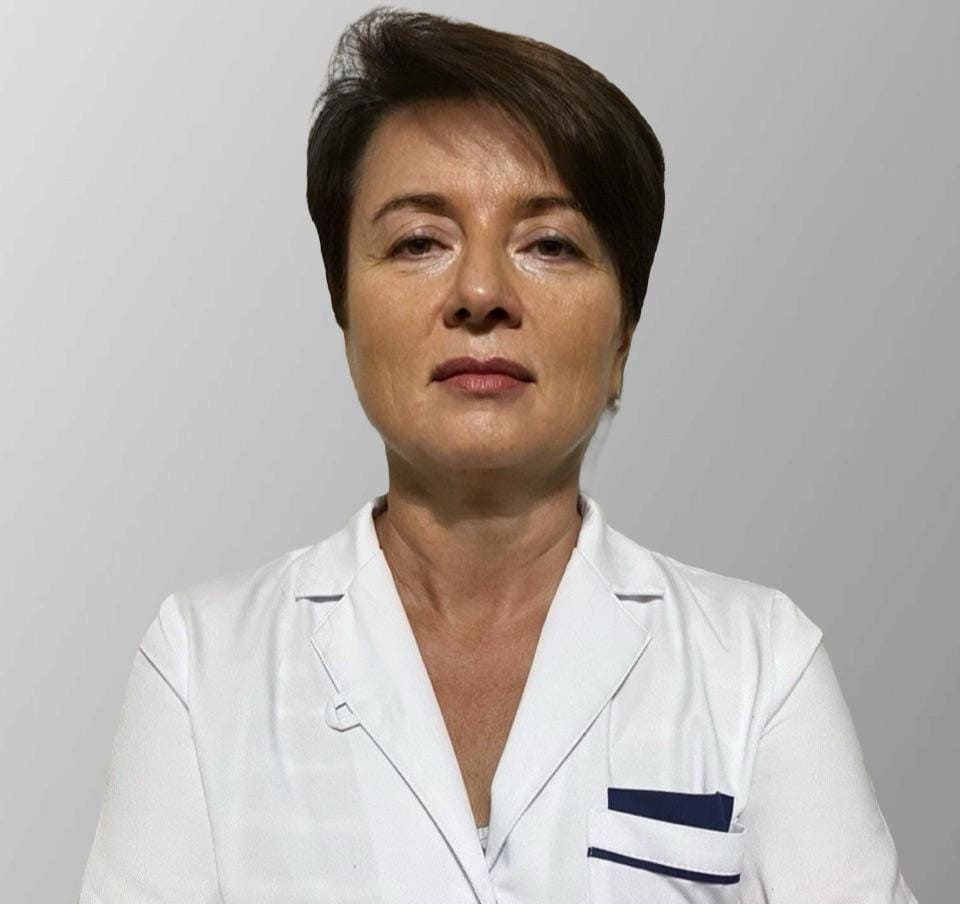

ЛОСАРТАН ВІАТРІС 50 мг ТАБЛЕТКИ, ПОКРИТІ ПЛІВКОВОЮ ОБОЛОНКОЮ

Запитайте лікаря про рецепт на ЛОСАРТАН ВІАТРІС 50 мг ТАБЛЕТКИ, ПОКРИТІ ПЛІВКОВОЮ ОБОЛОНКОЮ

Інструкція із застосування ЛОСАРТАН ВІАТРІС 50 мг ТАБЛЕТКИ, ПОКРИТІ ПЛІВКОВОЮ ОБОЛОНКОЮ
Вступ
Опис: інформація для користувача
Лозартан Віатріс 50 мг покриті таблетки з плівковим покриттям ЕФГ
лозартан потасій
Прочитайте уважно весь опис перед тим, як почнете приймати цей препарат, оскільки він містить важливу інформацію для вас.
- Збережіть цей опис, оскільки вам може знадобитися знову його прочитати.
- Якщо у вас є якісь сумніви, проконсультуйтеся з вашим лікарем або фармацевтом.
- Цей препарат призначений лише для вас, і не слід давати його іншим людям, навіть якщо вони мають相同ні симптоми, оскільки це може їм нашкодити.
- Якщо ви відчуваєте побічні ефекти, проконсультуйтеся з вашим лікарем або фармацевтом, навіть якщо це побічні ефекти, які не вказані в цьому описі. Див. розділ 4.
Зміст опису
- Що таке Лозартан Віатріс і для чого він використовується
- Що вам потрібно знати перед тим, як почнете приймати Лозартан Віатріс
- Як приймати Лозартан Віатріс
- Можливі побічні ефекти
5 Збереження Лозартану Віатріс
- Зміст упаковки та додаткова інформація
1. Що таке Лозартан Віатріс і для чого він використовується
Лозартан належить до групи препаратів, які називаються антагоністами рецепторів ангіотензину II.
Ангіотензин II - це речовина, яка виробляється в організмі і зв'язується з рецепторами, які знаходяться в кровоносних судинах, що призводить до їхнього звуження. Це призводить до підвищення артеріального тиску.
Лозартан перешкоджає зв'язуванню ангіотензину II з цими рецепторами, що призводить до розширення кровоносних судин, а це, в свою чергу, знижує артеріальний тиск. Лозартан знижує погіршення функції нирок у пацієнтів з підвищеним артеріальним тиском і цукровим діабетом 2 типу.
Лозартан використовується:
- Для лікування пацієнтів з підвищеним артеріальним тиском (гіпертензією).
- Для захисту нирок у пацієнтів з гіпертензією і цукровим діабетом 2 типу, а також з результатами лабораторних аналізів, які свідчать про ниркову недостатність і протеїнурію ≥ 0,5 г на добу (стан, при якому сеча містить ненормальну кількість білків).
- Для лікування пацієнтів з хронічною серцевою недостатністю, коли лікар вважає, що лікування препаратами, які називаються інгібіторами ангіотензинперетворюючої ферменти (інгібітори АПФ, препарати, які використовуються для зниження підвищеного артеріального тиску), не є доречним. Якщо серцева недостатність була стабілізована інгібітором АПФ, не слід змінювати його на лозартан.
- У пацієнтів з підвищеним артеріальним тиском і збільшенням товщини лівого шлуночка серця лозартан продемонстрував зниження ризику інсульту (індикація LIFE).
2. Що вам потрібно знати перед тим, як почнете приймати Лозартан Віатріс
Не приймайте Лозартан Віатріс
- Якщо ви алергічні на активну речовину або на будь-який інший компонент цього препарату (перелічені в розділі 6).
- Якщо функція вашої печінки сильно пошкоджена.
- Якщо у вас є цукровий діабет або ниркова недостатність і ви приймаєте препарат для зниження артеріального тиску, який містить аліскірен.
- Якщо ви вагітні більше 3 місяців. (Найкраще уникати лозартану також під час перших місяців вагітності - див. розділ вагітність).
Попередження та застереження
Проконсультуйтеся з вашим лікарем, фармацевтом або медсестрою перед тим, як почнете приймати Лозартан Віатріс.
Проконсультуйтеся з вашим лікарем, якщо ви відчуваєте біль у животі, нудоту, блювоту або діарею після прийому лозартану. Ваш лікар вирішить, чи продовжувати лікування. Не припиняйте приймати лозартан самостійно.
Повідомте вашого лікаря, якщо ви вагітні (або якщо ви підозрюєте, що можете бути вагітною). Не рекомендується використовувати лозартан на початку вагітності, і в жодному разі не слід приймати його після третього місяця вагітності, оскільки це може завдати серйозної шкоди вашому дитятку, коли його приймають після цього терміну (див. розділ вагітність).
Важливо повідомити вашому лікарю перед тим, як прийняти Лозартан Віатріс:
- Якщо у вас є анамнез ангіоедему (набухання обличчя, губ, язика і/або горла) (див. також розділ 4. Можливі побічні ефекти).
- Якщо у вас є сильна нудота або діарея, які призводять до надмірної втрати рідини і/або солі з вашого організму.
- Якщо ви приймаєте діуретики (препарати, які збільшують кількість води, яка проходить через ваші нирки) або якщо ви дотримуєтеся дієти з обмеженням солі, яка призводить до надмірної втрати рідини або солі з вашого організму (див. розділ 3. Посологія у спеціальних групах пацієнтів).
- Якщо ви знаєте, що у вас є звуження або блокування кровоносних судин, які прямують до ваших нирок, або якщо ви недавно перенесли трансплантацію нирки.
- Якщо функція вашої печінки порушена (див. розділи 2. Не приймайте Лозартан Віатріс і 3. Посологія у спеціальних групах пацієнтів).
- Якщо у вас є серцева недостатність з або без ниркової недостатності чи аритмій серця, які можуть бути смертельними. Потрібно звернути особливу увагу, коли ви приймаєте одночасно з бета-блокатором.
- Якщо у вас є проблеми з клапанами серця або з м'язом серця.
- Якщо у вас є коронарна хвороба серця (зумовлена зниженням кровотоку в кровоносних судинах серця) або цереброваскулярна хвороба (зумовлена зниженням кровотоку в мозку).
- Якщо у вас є первинний гіпералдостеронізм (синдром, пов'язаний з підвищеною секрецією гормону альдостерону надниркової залозою через порушення цієї залози).
- Якщо ви приймаєте будь-який з наступних препаратів, які використовуються для лікування артеріальної гіпертензії:
- Інгібітор ангіотензинперетворюючої ферменти (ІАПФ) (наприклад, еналаприл, лізиноприл, раміприл), особливо якщо у вас є проблеми з нирками, пов'язані з цукровим діабетом.
- Аліскірен.
Ваш лікар може контролювати функцію нирок, артеріальний тиск і рівень електролітів у крові (наприклад, калію) з регулярними інтервалами.
Див. також інформацію під заголовком "Не приймайте Лозартан Віатріс".
Інші препарати та Лозартан Віатріс
Повідомте вашому лікарю або фармацевту, якщо ви приймаєте, недавно приймали або можете приймати будь-який інший препарат.
Під час лікування Лозартаном Віатріс зверніть особливу увагу, якщо ви приймаєте будь-який з наступних препаратів:
- Інші препарати, які знижують артеріальний тиск, оскільки вони можуть призвести до додаткового зниження артеріального тиску. Артеріальний тиск також може знижуватися деякими з наступних препаратів/класів препаратів: трициклічні антидепресанти, антипсихотики, баклофен, аміфостин.
- Препарати, які зберігають калію або можуть збільшувати рівень калію (наприклад, добавки калію, замінники солі, які містять калію, або препарати, які зберігають калію, такі як деякі діуретики [амілорид, триамтерен, спіронолактон] або гепарин).
- Протизапальні препарати нестероїдної природи, такі як індометацин, включаючи інгібітори ЦОГ-2 (препарати, які знижують запалення і можуть використовуватися для полегшення болю), оскільки вони можуть знижувати ефект зниження артеріального тиску, який викликає лозартан.
Якщо функція нирок порушена, одночасне використання цих препаратів може призвести до погіршення функції нирок.
Препарати, які містять літій, не повинні використовуватися в поєднанні з лозартаном без того, щоб ваш лікар проводив ретельний контроль. Можливо, буде доречно приймати спеціальні заходи обережності (наприклад, аналіз крові).
Ваш лікар може потрібно змінити дозу і/або прийняти інші заходи обережності:
Якщо ви приймаєте інгібітор ангіотензинперетворюючої ферменти (ІАПФ) або аліскірен (див. також інформацію під заголовками "Не приймайте Лозартан Віатріс" і "Попередження та застереження").
Прийом Лозартану Віатріс з їжею та напоями
Лозартан можна приймати з або без їжі.
Не слід споживати грейпфрутовий сік під час прийому лозартану.
Вагітність та лактація
Вагітність
Якщо ви вагітні або перебуваєте в період лактації, вважаєте, що можете бути вагітною або плануєте вагітність, проконсультуйтеся з вашим лікарем або фармацевтом перед тим, як прийняти цей препарат. Ваш лікар, як правило, порадить вам припинити приймати лозартан перед тим, як ви станете вагітною, або як тільки дізнаєтеся, що ви вагітні, і порадить вам приймати інший препарат замість лозартану. Не рекомендується використовувати лозартан на початку вагітності, і в жодному разі не слід приймати його після третього місяця вагітності, оскільки це може завдати серйозної шкоди вашому дитятку, коли його приймають після цього терміну.
Лактація
Повідомте вашому лікарю, якщо ви перебуваєте в період лактації або плануєте його почати. Не рекомендується використання лозартану під час лактації, і ваш лікар обере інший препарат, якщо ви бажаєте годувати грудьми, особливо якщо ваша дитина народилася недоношеною.
Проконсультуйтеся з вашим лікарем або фармацевтом перед тим, як використовувати будь-який препарат.
Діти та підлітки
Лозартан був вивчений у дітей. Для більшої інформації зверніться до вашого лікаря.
Не рекомендується лозартан для використання у дітей, які мають проблеми з нирками або печінкою, оскільки даних про використання препарату в цих групах пацієнтів обмежені. Не рекомендується лозартан для використання у дітей молодше 6 років, оскільки не було доведено, що він діє в цій віковій групі.
Водіння транспортних засобів та використання машин
Не були проведені дослідження про вплив на здатність водити транспортні засоби та використовувати машини.
Мало ймовірно, що лозартан вплине на вашу здатність водити транспортні засоби або використовувати машини. Однак, як і багато препаратів, які використовуються для лікування артеріальної гіпертензії, лозартан може викликати головокружіння або сонливість у деяких людей. Якщо ви відчуваєте головокружіння або сонливість, проконсультуйтеся з вашим лікарем перед тим, як виконувати такі дії.
Лозартан Віатріс містить лактозу
Цей препарат містить лактозу. Якщо ваш лікар порадив вам, що ви маєте непереносимість деяких цукрів, проконсультуйтеся з ним перед тим, як прийняти цей препарат.
3. Як приймати Лозартан Віатріс
Слідуйте точно інструкціям щодо прийому цього препарату, вказаним вашим лікарем. У разі сумнівів проконсультуйтеся з вашим лікарем або фармацевтом.
Ваш лікар вирішить про доречну дозу лозартану, залежно від вашого стану та того, чи приймаєте ви інші препарати. важливо продовжувати приймати лозартан, поки ваш лікар не порадить вам припинити лікування, щоб підтримувати постійний контроль над артеріальним тиском.
Пацієнти з артеріальною гіпертензією
Зазвичай лікування починається з 50 мг лозартану (одна таблетка лозартану 50 мг) один раз на добу. Максимальний ефект зниження артеріального тиску досягається через 3-6 тижнів після початку лікування. Після цього у деяких пацієнтів дозу можна збільшити до 100 мг лозартану (дві таблетки лозартану 50 мг) один раз на добу.
Якщо ви вважаєте, що дія лозартану надто сильна або надто слабка, повідомте вашому лікарю або фармацевту.
Використання у дітей та підлітках
Діти молодше 6 років
Не рекомендується лозартан для використання у дітей молодше 6 років, оскільки не було доведено, що він діє в цій віковій групі.
Діти у віці від 6 до 18 років
Рекомендована початкова доза для пацієнтів, які важать від 20 до 50 кг, становить 0,7 мг лозартану на кілограм ваги, приймається один раз на добу (до 25 мг лозартану). Лікар може збільшити дозу, якщо артеріальний тиск не контролюється.
Інша(і) фармацевтична(і) форма(и) цього препарату може(ють) бути більш доречними для дітей; проконсультуйтеся з вашим лікарем або фармацевтом.
Пацієнти з артеріальною гіпертензією та цукровим діабетом 2 типу
Зазвичай лікування починається з 50 мг лозартану (одна таблетка лозартану 50 мг) один раз на добу. Після цього дозу можна збільшити до 100 мг лозартану (дві таблетки лозартану 50 мг) один раз на добу, залежно від реакції артеріального тиску.
Таблетки лозартану можна приймати разом з іншими препаратами, які знижують артеріальний тиск (наприклад, діуретики, антагоністи кальцію, альфа- або бета-блокатори та препарати центрального дії), а також з інсуліном та іншими препаратами, які часто використовуються для зниження рівня глюкози в крові (наприклад, сульфонілурети, глітазони та інгібітори глюкозидази).
Пацієнти з серцевою недостатністю
Зазвичай лікування починається з 12,5 мг лозартану (одна таблетка лозартану 12,5 мг Початок) один раз на добу. Зазвичай дозу збільшують поступово, щотижня (тобто 12,5 мг на добу протягом першого тижня, 25 мг на добу протягом другого тижня та 50 мг на добу протягом третього тижня), до підтримуючої дози 50 мг лозартану (одна таблетка лозартану 50 мг) один раз на добу, залежно від вашого стану.
При лікуванні серцевої недостатності лозартан зазвичай комбінується з діуретиком (препаратом, який збільшує кількість води, яка проходить через ваші нирки) та/або дигоксином (препаратом, який допомагає вашому серцю бути сильнішим і більш ефективним) та/або бета-блокатором.
Посологія у спеціальних групах пацієнтів
Лікар може порекомендувати меншу дозу, особливо на початку лікування, у деяких пацієнтів, таких як ті, хто приймає діуретики у високих дозах, пацієнти з нирковою недостатністю або пацієнти старше 75 років. Не рекомендується використання лозартану у пацієнтів з тяжкою нирковою недостатністю (див. розділ "Не приймайте Лозартан Віатріс").
Прийом
Таблетки потрібно приймати з склянкою води. Ви повинні спробувати приймати свою добову дозу приблизно в один і той же час кожного дня. важливо продовжувати приймати лозартан, поки ваш лікар не порадить вам припинити лікування.
Якщо ви прийняли过 багато Лозартану Віатріс
Якщо ви випадково прийняли过 багато таблеток, або якщо дитина прийняла деякі з них, негайно зверніться до вашого лікаря. Симптоми передозування включають зниження артеріального тиску, збільшення частоти серцевих скорочень та можливе зниження частоти серцевих скорочень.
У разі передозування або випадкового прийому зверніться негайно до вашого лікаря або фармацевта або телефонуйте до служби токсикологічної інформації, телефон 91 562 04 20, вказуючи препарат і кількість, прийняту.
Якщо ви забули прийняти Лозартан Віатріс
Якщо ви випадково забули прийняти дозу, просто прийміть наступну дозу з нормального графіку. Не приймайте подвійну дозу, щоб компенсувати забуту таблетку. Якщо у вас є будь-які інші питання щодо використання цього препарату, проконсультуйтеся з вашим лікарем або фармацевтом.
4. Можливі побічні ефекти
Як і всі лікарські засоби, цей лікарський засіб може спричинити побічні ефекти, хоча не всі люди їх відчувають.
Якщо ви відчуваєте наступне, припиніть приймати таблетки лозартану та повідоміть про це своєму лікареві негайно або зверніться до відділення невідкладної допомоги найближчої лікарні:
Важка алергічна реакція (виразка на шкірі, свербіж, набряк обличчя, губ, рота або горла, що можуть спричинити труднощі з ковтанням або диханням).
Це важкий, але рідкісний побічний ефект (може вплинути на до 1 особи з 1000). Ви можете потребувати термінової медичної допомоги або госпіталізації.
Наступні побічні ефекти були повідомлені щодо лозартану:
Часті(можуть вплинути на до 1 особи з 10)
- Вертігін.
- Низький артеріальний тиск (особливо після надмірної втрати води з організму всередині кров'яних судин, наприклад, у пацієнтів з важкою серцевою недостатністю або при лікуванні високими дозами діуретиків).
- Ортостатичні ефекти, пов'язані з дозою, такі як зниження артеріального тиску, яке відбувається після підняття з положення лежачи або сидячого.
- Слабкість.
- Втома.
- Низький рівень цукру в крові (гіпоглікемія).
- Збільшення рівня калію в крові (гіперкаліємія).
- Зміни функції нирок, включаючи ниркову недостатність.
- Зниження кількості червоних кров'яних тілечок (анемія).
- Збільшення рівня сечовини, креатиніну та калію в крові у пацієнтів з серцевою недостатністю.
Нечасті(можуть вплинути на до 1 особи з 100)
- Сонливість.
- Головний біль.
- Розлади сну.
- Чуття швидких серцевих скорочень (пальпітації).
- Сильний біль у грудній клітці (стенокардія).
- Труднощі з диханням (диспное).
- Біль у животі.
- Запор.
- Приспешення.
- Нудота.
- Воміта.
- Кропив'янка (уртикарія).
- Свербіж (прурит).
- Виразка.
- Місцевий набряк (едем).
- Кашель.
Рідкісні(можуть вплинути на до 1 особи з 1000)
- Гіперчутливість.
- Ангіоневротичний набряк.
- Васкуліт (включаючи пурпуру Шенлейна-Геноха).
- Оніміння або відчуття поколювання (парестезія).
- Омана (синкоп).
- Швидкі та нерегулярні серцеві скорочення (фібриляція передсердь).
- Інсульт.
- Гепатит.
- Збільшення рівня аланінамінотрансферази (АЛТ) в крові, яке зазвичай нормалізується після припинення лікування.
- Ангіоневротичний набряк кишечника: набряк у кишечнику, який проявляється симптомами, такими як біль у животі, нудота, воміта та діарея.
Частота невідома(частота не може бути оцінена з наявних даних)
- Зниження кількості тромбоцитів.
- Мігрень.
- Аномалії функції печінки.
- Біль у м'язах та суглобах.
- Симптоми, подібні до грипу.
- Біль у спині та інфекція сечовивідних шляхів.
- Збільшена чутливість до сонячного світла (фоточутливість).
- Біль у м'язах невідомої етіології з темною сечею (рабдоміоліз).
- Імпотенція.
- Панкреатит,
- Низький рівень натрію в крові (гіпонатремія).
- Депресія.
- Загальне відчуття недуги (диспное).
- Дзвін у вухах, звук або щелепіння в вухах (акуфени).
- Порушення смаку (дисгевзія).
Побічні ефекти у дітей подібні до тих, що спостерігаються у дорослих.
.
Повідомлення про побічні ефекти
Якщо ви відчуваєте будь-який побічний ефект, проконсультуйтеся з лікарем, фармацевтом або медсестрою, навіть якщо це можливі побічні ефекти, які не вказані в цьому листку-вкладиші. Ви також можете повідомити про них безпосередньо через Іспанську систему фармакологічного нагляду за лікарськими засобами для людини: https://www.notificaram.es. Повідомляючи про побічні ефекти, ви можете допомогти надати більше інформації про безпеку цього лікарського засобу
5. Зберігання Лозартану Віатріс
Тримайте цей лікарський засіб поза зоною видимості та досягнення дітей.
Не використовуйте цей лікарський засіб після закінчення терміну придатності, вказаного на упаковці після CAD або EXP. Термін придатності - останній день місяця, вказаного на упаковці.
Зберігайте цей лікарський засіб в оригінальній упаковці.
Не відкривайте блистер до тих пір, поки не будете готові прийняти лікарський засіб.
Лікарські засоби не повинні викидатися у водопровідні труби чи сміття. Відкладайте упаковки та лікарські засоби, які вам не потрібні, у пункт збору лікарських засобів у аптеці. У разі сумнівів запитайте у фармацевта, як позбутися упаковок та лікарських засобів, які вам не потрібні. Таким чином, ви допоможете захистити навколишнє середовище.
6. Зміст упаковки та додаткова інформація
Склад Лозартану Віатріс
Активний інгредієнт - лозартан (у вигляді потасової солі). Кожна таблетка містить 50 мг лозартану (у вигляді потасової солі). Містить калій у кількості: 4,24 мг (0,108 мЕкв).
Інші складові частини - лактоза моногідрат, кукурудзяний крохмаль, мікрокристалічна целюлоза (Е-460), стеарат магнію (Е-470Б), гідроксипропілцелюлоза (Е-463), гідроксипропілметилцелюлоза (Е-464) та діоксид титану (Е-171).
Вигляд продукту та вміст упаковки
Лозартан Віатріс - це плівкові таблетки без рисок.
Випускається у блистерах по 28 плівкових таблеток.
Уповноважений на отримання дозволу на продаж та відповідальний за виробництво
Уповноважений на отримання дозволу на продаж:
Viatris Pharmaceuticals, S.L.U.
C/ General Aranaz, 86
28027 - Мадрид
Іспанія
Відповідальний за виробництво
Laboratorios Liconsa, S.A.
Avda. Miralcampo, Nº 7, Pol. Ind. Miralcampo
19200 - Azuqueca de Henares (Гвадалахара)
Іспанія
Дата останньої ревізії цього листка-вкладишу:березень 2025
Детальна інформація про цей лікарський засіб доступна на сайті Іспанського агентства лікарських засобів та медичних продуктів (AEMPS) http://www.aemps.gob.es/

Скільки коштує ЛОСАРТАН ВІАТРІС 50 мг ТАБЛЕТКИ, ПОКРИТІ ПЛІВКОВОЮ ОБОЛОНКОЮ в Іспанії у 2025 році?
ЛОСАРТАН ВІАТРІС 50 мг ТАБЛЕТКИ, ПОКРИТІ ПЛІВКОВОЮ ОБОЛОНКОЮ коштує в середньому 4.17 євро у грудень, 2025 році. Ціна може змінюватися залежно від регіону, аптеки та наявності рецепта. Рекомендуємо перевіряти актуальну вартість у місцевих аптеках або через онлайн-сервіси.
- Країна реєстрації
- Середня ціна в аптеках4.17 EUR
- Діючі речовини
- Потрібен рецептТак
- Виробник
- Інформація є довідковою і не є медичною порадою. Перед прийомом будь-яких препаратів обов'язково проконсультуйтеся з лікарем. Oladoctor не несе відповідальності за медичні рішення, прийняті на основі цього контенту.
- Альтернативи до ЛОСАРТАН ВІАТРІС 50 мг ТАБЛЕТКИ, ПОКРИТІ ПЛІВКОВОЮ ОБОЛОНКОЮФорма випуску: ТАБЛЕТКА, 100 мг лозартану каліюДіючі речовини: losartanВиробник: Organon Salud S.L.Потрібен рецептФорма випуску: ТАБЛЕТКА, 12,5 мг лозартану каліюДіючі речовини: losartanВиробник: Organon Salud S.L.Потрібен рецептФорма випуску: ТАБЛЕТКА, 50 мг лозартану каліюДіючі речовини: losartanВиробник: Organon Salud S.L.Потрібен рецепт
Аналоги ЛОСАРТАН ВІАТРІС 50 мг ТАБЛЕТКИ, ПОКРИТІ ПЛІВКОВОЮ ОБОЛОНКОЮ в інших країнах
Найкращі аналоги з тією самою діючою речовиною та терапевтичним ефектом.
Аналог ЛОСАРТАН ВІАТРІС 50 мг ТАБЛЕТКИ, ПОКРИТІ ПЛІВКОВОЮ ОБОЛОНКОЮ у Польша
Аналог ЛОСАРТАН ВІАТРІС 50 мг ТАБЛЕТКИ, ПОКРИТІ ПЛІВКОВОЮ ОБОЛОНКОЮ у Украина
Лікарі онлайн щодо ЛОСАРТАН ВІАТРІС 50 мг ТАБЛЕТКИ, ПОКРИТІ ПЛІВКОВОЮ ОБОЛОНКОЮ
Консультація щодо дозування, побічних ефектів, взаємодій, протипоказань та поновлення рецепта на ЛОСАРТАН ВІАТРІС 50 мг ТАБЛЕТКИ, ПОКРИТІ ПЛІВКОВОЮ ОБОЛОНКОЮ – за рішенням лікаря та згідно з місцевими правилами.










